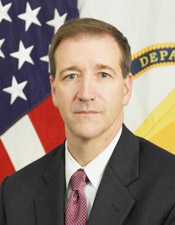May 1, 2012
 A Thought Leader Series Piece
A Thought Leader Series Piece
By Richard Kidd
Note: ASU was selected by the Army National Guard to partner in the development and delivery of an online Graduate Certificate in Sustainability Leadership designed exclusively for Soldiers and Army-related civilians. Classes are offered through the School of Sustainability.
Imagine the U.S. Army called to war with no fuel, no supplies, and no training.
You can’t. To safeguard against such a scenario, the Army embraces sustainability as a foundation of its global mission, operations, and strategic management. As a matter of preparedness, sustainability is integrated across the Army’s four lines of operation – material, military training, personnel, and services and infrastructure.
This is not a fad, but serious business. Army leaders have been working since 2000 to embed sustainability into the Army’s culture. Through collaborations with academia, federal agencies, and other organizations, and by emphasizing the key role sustainability plays in enabling operations at home and overseas, the Army has shifted its behavior. A strong culture of sustainability now ensures that the Army of tomorrow has the same access to energy, water, land, and other natural resources as it does today.
Net Zero is one of the Army’s signature initiatives in its move toward sustainability. Designed to manage energy and natural resources at Army facilities in an efficient and effective way, this initiative recognizes the value of sustainable approaches. Among the advantages are reduced cost, improved mission capability, healthier quality of life, better relationships with local communities, and increased future options. These are crucial to preserving choice on strategy and installations and to help the Army prepare for future contingencies.
Net Zero works by focusing on three interrelated areas: energy, water, and solid waste. The objective by 2020 is to avoid consuming more energy or water than is sustainably produced and to eliminate solid waste disposal in landfills. Army facilities have begun moving toward this goal. As of April 2012, 17 Army installations differing in size, geography, and mission have been identified as Net Zero pilot projects to test and demonstrate a variety of sustainable practices.
In parallel with Net Zero, the Army has launched the Operational Energy and Contingency Basing initiatives to incorporate sustainability in its contingency operations (actions potentially involving enemy hostilities). The Army clearly recognizes that sustainability on the battlefield is a force multiplier that, when implemented, can increase the combat potential of a military unit and enhance the probability of a successful mission.
The Operational Energy and Contingency Basing initiatives address sustainability in three vital areas: Soldier equipment, forward operating bases, and tactical vehicles. They focus on both increasing energy and water efficiency and also reducing energy and water needs as well as solid waste. By conducting energy-efficient and sustainability-informed operations, the Army reduces vulnerabilities and decreases its logistics tail. It also increases lethality by lightening the Soldier’s load and freeing up more Soldiers for mission-oriented, rather than logistical tasks.
Tracking results is also critically important to sustainability, and the Army has been a leader in both measuring and publicly disclosing its progress. Since 2008, the Army has published annual self-assessments using the criteria established by the highly respected Global Reporting Initiative (GRI). The Army was also the first federal organization to link its annual GRI report to the sustainability goals in Executive Order 13514, which requires reductions in greenhouse gas emissions, increases in energy and water efficiency, and continued reductions in the generation of solid waste.
To be relevant to the current and future Army, new concepts must be appropriate to its mission. Sustainability meets that standard. It is now both a way of thinking and a way of doing that improves the Army’s efficiency. This gives the Army more choice and flexibility, and that ultimately means greater effectiveness.
About the author: Richard Kidd serves as Deputy Assistant Secretary of the U.S. Army (Energy & Sustainability) where he is responsible for overall program direction, policies, strategies, and oversight for implementation of all programs and initiatives related to energy security and sustainability within the Army. As the Army’s senior energy executive, he also coordinates and integrates both installation and operational energy programs and strategies. A 1986 graduate of the United States Military Academy at West Point, Kidd served as an Infantry Officer until 1991. After receiving a master’s degree in public and private management from Yale University, he joined the United Nations and served principally in war-affected regions of the world. He served in the U.S. State Department’s Bureau of Political Military-Affairs starting in 2001. In July of 2008 he joined the U.S. Department of Energy’s Office of Energy Efficiency and Renewable Energy where he was responsible for leading the Federal Energy Management Program. In this position he helped craft federal-level energy policy and assisted all federal agencies in meeting statutory energy and sustainability requirements in order to promote energy security and environmental stewardship.
For additional information:
U.S. Army Energy Security and Sustainability: Vital to National Defense
Army Sustainability Report 2010
This commentary was prepared in collaboration with Marc Kodack, Kristine Kingery, Wanda Johnson, and Natalie Jones, all from the Office of the Assistant Secretary of the Army for Energy and Sustainability.


 A Thought Leader Series Piece
A Thought Leader Series Piece